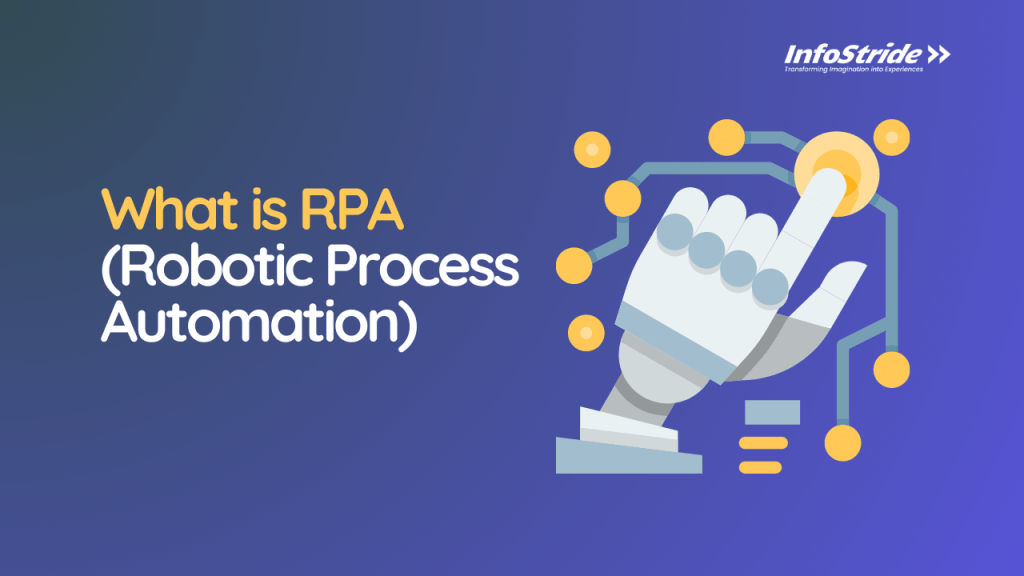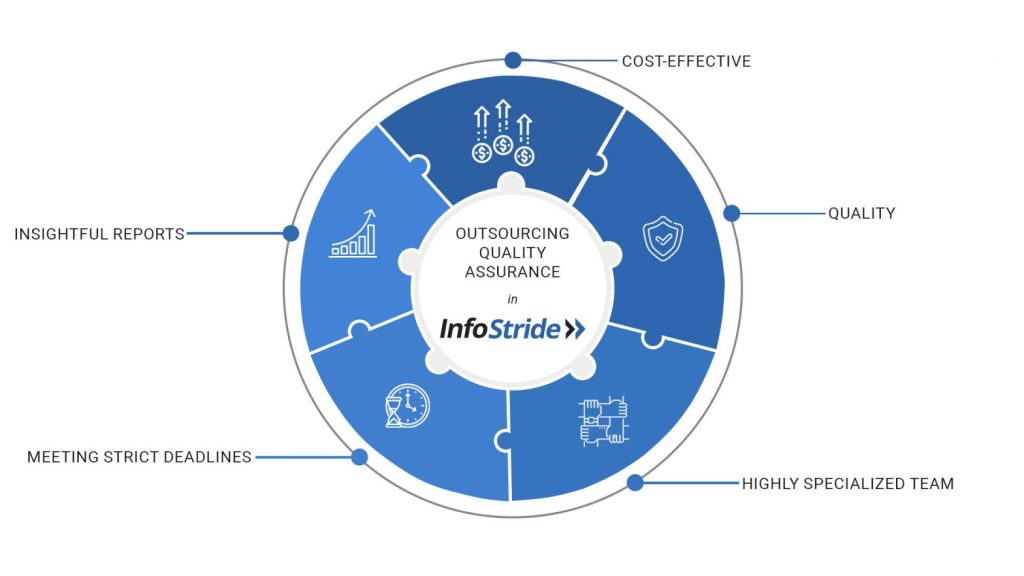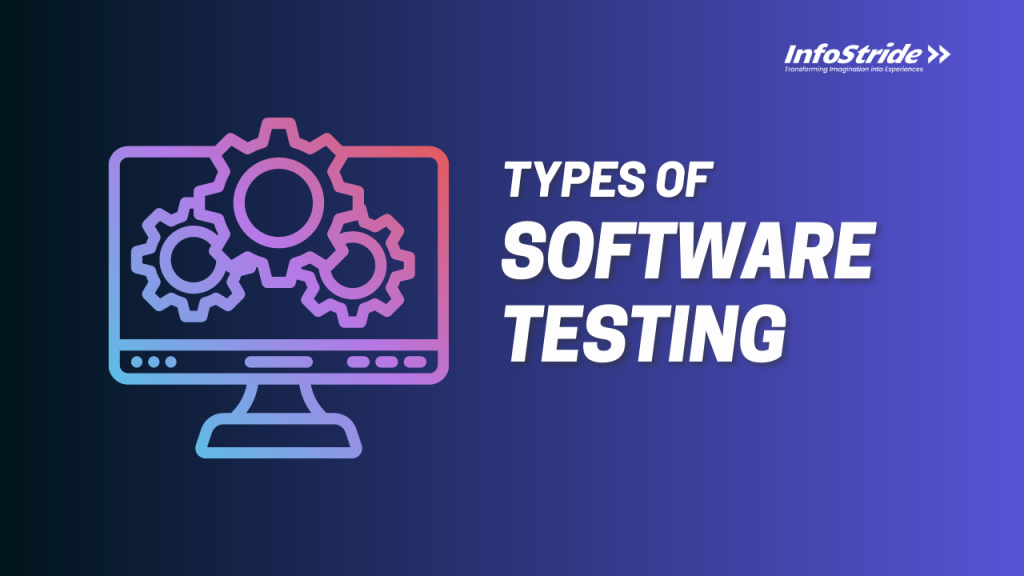Table of Content
Why Invest in Food Delivery Apps Like Uber Eats? - Key Facts and Stats
From Order to Delivery: A Closer Look at How Does Uber Eats Work
What Makes Uber Eats Shine: Unveiling Its Features that Leave Competitors Behind
Uber Eats Business Model: Decoding Its Business Strategy
Uber Eats Revenue Model: A Deep Dive into Its Revenue Streams
From Idea to Launch: A Step-by-Step Guide on How to Build an App Like Uber Eats?
How Can InfoStride Help in Launching Your Food Delivery Business?
Food delivery apps are experiencing a continuous surge in popularity thanks to the unmatched convenience they offer to avid food enthusiasts. Thus, it’s not surprising to see many new players who want to enter the market by building a similar food delivery app like Uber Eats.
Uber Eats, a household name in the food delivery landscape, stands at the forefront of transforming food delivery experiences. Since its inception in 2014, Uber Eats has witnessed remarkable growth, carving its niche and extending its global presence. With an impressive user base of over 88 million and a network of 900,000 restaurants, Uber Eats has become a dominant player in the online food delivery industry.
In this article, we aim to shed light on the essential considerations for entrepreneurs looking to embark on the thrilling adventure of developing an app like Uber Eats.
But before we get into how to build an app like Uber Eats, let’s first have a look at why startups should invest in food delivery app development.
Why Invest in Food Delivery Apps Like Uber Eats? – Key Facts and Stats
The online food delivery industry is growing by the hour, with a global value expected to hit $505.50 billion by 2030. Launched in 2014 by Uber Technologies, Uber Eats is one of the market leaders in the food delivery industry. By 2016, it was already operating in dozens of cities across the United States and various countries, including Canada, India, Australia, and several European nations.
Thus, investing in food delivery apps like Uber Eats presents a lucrative business opportunity for aspiring entrepreneurs and startups, given the growing demand for convenience in food ordering and the high potential for substantial returns.
When you delve into the numbers of Uber Eats, it becomes evident why many entrepreneurs aim to emulate its remarkable success or invest in on-demand app development ideas.

From Order to Delivery: A Closer Look at How Does Uber Eats Work
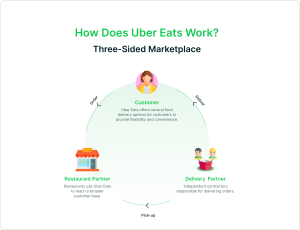
Uber Eats operates as a three-sided marketplace that connects customers, restaurants and delivery agents. Here’s a quick step-by-step breakdown of how the Uber Eats app works:
- A customer browses restaurant options and places orders through the Uber Eats app.
- Restaurants receive and prepare the orders upon confirmation.
- Uber Eats assigns a nearby delivery driver to pick up the order from the restaurant.
- The customer can track the real-time progress of their delivery through the app.
- The driver delivers the order to the specified address, and the customer receives a confirmation upon delivery.
- Once the order is completed, Uber Eats deducts its commission and releases the remaining order value to the restaurants.
What Makes Uber Eats Shine: Unveiling Its Features that Leave Competitors Behind
Uber Eats has become the most popular food delivery app in the world. It has been able to achieve this remarkable success by offering a number of unique features, which include but are not limited to:
-
Extensive restaurant selection
Uber Eats partners with approximately 900,000 restaurants across the globe – from poke shops to pasta spots to cater to various tastes and preferences. This extensive selection allows users to order from their favorite local eateries or try new cuisines easily.
-
Scheduled orders
Uber Eats offers the option to schedule an order in advance. This feature is convenient for customers planning meals for a specific time or event.
-
Customize the drop-off location
With Uber Eats, customers have the power to specify precisely where they want their food delivered. Whether at home, in the office or enjoying a day at the park with family, customers can provide even more specific instructions to tailor their drop-off location.
-
Group ordering
Uber Eats supports group ordering and bill splitting, wherein it lets multiple users add their favorite items to a single order and have it delivered to a single location. This is a convenient option for people who are having a party or gathering.
-
Priority delivery option
Uber Eats offers a feature called “Priority Delivery” that promises shorter delivery times for an additional fee in certain regions.
Uber Eats Business Model: Decoding Its Business Strategy
Uber Eats operates on an order and delivery model. It acts as a platform that connects customers with restaurants and arranges for the delivery of food orders.
-
Customer ordering
Customers use the Uber Eats app or website to browse menus, place food orders and make payments. The platform provides accurate real-time tracking of the delivery process, allowing customers to track their orders from preparation to delivery.
-
Restaurant partnerships
Uber Eats partners with a wide range of restaurants, including local eateries and well-known chains. These restaurants are featured on the platform, allowing them to expand their reach and offer delivery services without the need for their own delivery infrastructure.
-
Delivery network
Uber Eats relies on a network of independent delivery drivers who use their own vehicles to pick up orders from restaurants and deliver them to customers.
Uber Eats Revenue Model: A Deep Dive into Its Revenue Streams
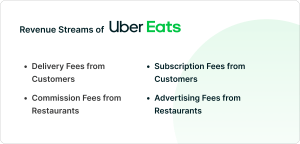
In 2022, Uber Eats revenue touched $10.9 billion. It makes money through a combination of fees, commissions and service charges from various stakeholders involved in its food delivery business.
Here are some of the primary monetization ways through which Uber Eats brings money to the table:
-
Delivery fees from customers
Uber Eats charges a delivery fee to customers on each order placed through its platform. The delivery fee varies depending on the distance between the restaurant and the customer’s location, as well as the market in which the company is operating.
Uber Eats charges its customers for the food delivered via its platform. The delivery fees are divided into three categories:
Delivery fee
Uber Eats charges a delivery fee to customers on each order placed through its platform. The delivery fee varies depending on the distance between the restaurant and the customer’s location, as well as the market in which the company is operating.
Service fee
Uber Eats charges a service fee of 15% of the order’s subtotal.
Order fee
If the order total falls below $10, a small order fee of $2 is charged.
-
Commission fees from restaurants
Uber Eats cuts 15% to 40% of the total value on every order from the restaurant partners. However, the percentage of the commission can vary depending on the age and maturity of the market.
-
Marketing & advertising fees from restaurants
Uber Eats offers restaurants the option to promote their listings through the app to attract more customers and reach a wider customer base. The company charges additional fees to restaurants to have their menus featured prominently or to run special promotions. These fees contribute to Uber Eats’ revenue.
-
Premium subscriptions
Uber Eats offers premium subscriptions such as Uber One and Eats Pass to customers interested in special benefits, such as free delivery, exclusive access to menu items and priority delivery. These subscriptions are a great source of recurring revenue for the company, as customers pay a monthly fee to enjoy these perks.
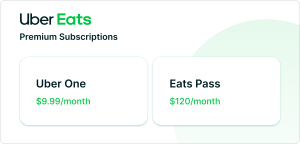
Overall, Uber Eats works on a multifaceted revenue model that combines delivery fees, commissions, advertising, subscription services, and various other strategic initiatives such as surge pricing and partnerships with other companies to generate revenue.
From Idea to Launch: A Step-by-Step Guide on How to Build an App Like Uber Eats?
It’s time to answer the main question: how to build an app like Uber Eats?
Building food delivery apps like Uber Eats involves a series of steps, from conceptualizing the idea to marketing your app. Here’s a step-by-step guide on how to make an app like Uber Eats:
Step 1: Research the market
The first step towards building a food delivery app is to perform comprehensive research about your key competitors, target audience and emerging on-demand food delivery industry trends.
- Identify existing food delivery services in your target area. Study their business models, strengths, weaknesses and features.
- Analyze the pricing strategies of competitors and evaluate the profitability of different pricing models.
- Keep pace with changing customer demands and their purchasing behavior to come up with features that deliver a superior experience to them.
- Understand the regulatory environment for food delivery services in your region. Research permits, licenses, health and safety standards and any legal requirements.
- Study user reviews and feedback on existing platforms to identify pain points, areas of improvement and features that resonate with customers.
Step 2: Choose a food delivery business model
The next step is to choose the business model for your on-demand food delivery business. There are three main types of food delivery business models:
- The Order Only Model: In this model, your platform primarily focuses on receiving customer orders and forwarding them to partnering restaurants. The responsibility for food preparation and delivery lies entirely with the restaurants.
- The Order and Delivery Model: This model involves both receiving customer orders and managing the delivery process. While partnering with restaurants for food preparation, your business takes charge of the delivery logistics. You may employ a fleet of drivers or utilize third-party delivery services to ensure timely and efficient deliveries.
- The Fully Integrated Model: The fully integrated model encompasses all aspects of the food delivery process, from receiving orders and preparing food to managing deliveries. In this model, you might operate cloud kitchens or virtual restaurants to prepare meals, ensuring consistency and quality.

Step 3: Choose key features of your food delivery app
In the food delivery business, four main types of apps contribute to the overall ecosystem. Let’s have a look and at their must-have features:
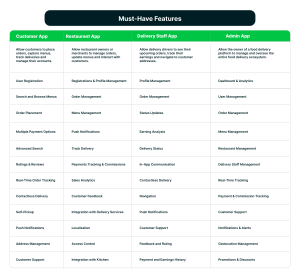
Step 4: Pick the right technology stack
The technology stack refers to the combination of programming languages, frameworks, libraries, databases and tools used to build an app. When it comes to how to build an app like Uber Eats, choosing the right tech stack is pivotal as it serves as the cornerstone for delivering a smooth user experience.
Whether you decide to build your food delivery app only for Android or iOS or both platforms, you might need different technologies to realize your idea.
For example, building an app for Android and iOS through a native app development approach requires creating separate codebases, as the two platforms have different programming languages (Swift for iOS, Java/Kotlin for Android).
On the other hand, if you go for a cross-platform development approach to build your food delivery for both Android and iOS using a single codebase, you need to include React Native or Flutter in your tech stack.
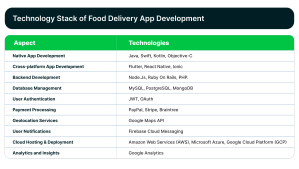
Step 5: Hire an on-demand app development company
Building a food delivery app like Uber Eats requires a range of tech resources to ensure successful development, launch and ongoing operation such as UI/UX designer, Android developer, iOS developer, business analyst and QA & testing engineer. A reliable on-demand app development company is armed with a full-scale development team to extend support from development to deployment and ongoing maintenance.
Step 6: Build an MVP
You should work with an on-demand mobile app development company with expertise in MVP app development for startups.
An MVP or Minimum Viable Product represents the app’s basic version, featuring core functionalities that convey the app’s core purpose without including the full array of advanced features. The idea behind building an MVP is to gauge user interest and market demand with minimal investment. It helps verify if your app idea resonates with users before committing to full-scale development.
There are several successful MVP examples from elite brands that started their journey with an MVP and became world-renowned businesses such as Amazon, Twitter and Spotify.
Step 7: Perform rigorous testing
While it may be tempting to skip thorough testing when working with a tight budget, quality assurance (QA) remains a pivotal component in launching a successful app. Given the fierce competition in on-demand food delivery app development, continuous QA and performance testing must be integrated throughout the entire project lifecycle. This proactive approach enables you to pinpoint and rectify any bugs, ensuring that the app undergoes necessary improvements before its launch to customers.
Step 8: Rollout your app
After testing your app, the next step is to submit it to either the Apple App Store or Google Play Store or both depending on the targeted platforms. However, it’s essential to adhere to the respective developer guidelines set forth by Google and Apple when submitting your app to these platforms.
Step 9: Post-launch app maintenance
After successfully launching your app on Play Store/App Store, the next and continuous step is the maintenance of your food delivery app to ensure that the app continues to function smoothly, remains up to date and keeps pace with evolving user expectations.
Step 10: Market your food delivery app
In the fiercely competitive landscape of the food delivery industry with many strong key players already vying for market share, it is essential to get your app noticed and downloaded by users. This means leveraging data-driven growth marketing strategies such as social media marketing, hyper-targeting and email marketing to drive user acquisition, engagement, revenue and long-term success for your food delivery app.
How Can InfoStride Help in Launching Your Food Delivery Business?
InfoStride is renowned for its tailored on-demand food delivery app development solutions, covering the entire spectrum from initial idea conceptualization to design, development, deployment and growth marketing. Our seasoned team comprises skilled consultants and developers with an in-depth knowledge of the on-demand food delivery sector.
Whether you aspire to develop a food delivery app like Uber Eats, DoorDash or Postmates, our experts are well-equipped to steer you through the entire on-demand food delivery app development journey, elevating your business to new heights. Reach out to us today and let’s get started.
FAQs
1. How much does it cost to build an app like Uber Eats?
The food delivery app development cost like Uber Eats can range from $40,000 to $300,000, depending on a number of factors, including the complexity of the app, the features you want to include, the development team you hire and the chosen technology stack. It’s best to consult with experts to get an accurate estimation to build your own food delivery app.
2. How long does it take to develop food delivery apps like Uber Eats?
The time required to develop a food delivery app like Uber Eats can also vary widely based on various factors, including the complexity of the app, the features you want to include, the size and expertise of your development team and your project management approach. To give you a rough estimate, a basic food delivery app with the essential features can take around 6-8 months to develop. A more complex app with advanced features may take 12-18 months to develop.
3. What are some pre-launch marketing strategies for my food delivery app?
Pre-launch marketing is pivotal for building awareness, generating interest and acquiring early users for your food delivery app. Here are some effective pre-launch marketing strategies to consider:
- Create a compelling landing page that highlights the key features and benefits of your app.
- Generate excitement by running teaser campaigns on social media platforms, using catchy visuals and intriguing captions.
- Create and optimize social media profiles for your app on platforms like Facebook, Instagram, Twitter and LinkedIn.
- Reach out to influencers in your target market to promote your app to their followers.
- Build an email list through your landing page and social media channels to send regular newsletters with updates, sneak peeks and exclusive offers to keep potential users engaged.
4. How can I stay ahead of the competition and adapt to changing market dynamics?
The on-demand food delivery industry is a highly competitive one, so it’s important to stay ahead of the curve. Here are a few tips:
- Offer a unique value proposition and it could be anything from a wider selection of restaurants to faster delivery times.
- Leverage technology to improve your app and make it more user-friendly. This could include things like live tracking, push notifications, chatbots, AI and data analytics.
- Offer multiple delivery options, including standard, express, and scheduled deliveries, to cater to different customer needs.
- Stay updated with the latest technology trends and innovations in the food delivery industry such as new delivery options such as drones, parachutes and robots.
- Invest in a strong brand identity and growth marketing campaigns to differentiate your app from competitors.


